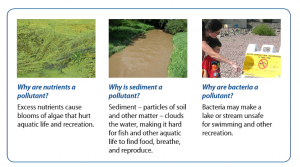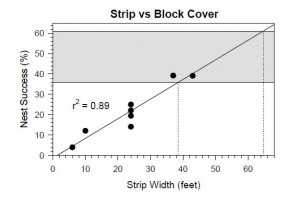This month, the Minnesota Department of Natural Resources (http://www.dnr.state.mn.us/buffers/index.html) will begin steps to implement Governor Mark Dayton’s new landmark buffer initiative, that was signed into law last month. The law will designate an estimated 110,000 acres of land statewide for vegetative buffer zones that will grow perennial vegetation up to 50 feet along rivers, streams, and ditches.
The benefits of this initiative are impressive. Buffers are a proven best practice when it comes to conservation and water quality and provide significant improvements to water quality, flood water storage, in-stream habitat for fish, and multiple benefits for other wildlife and pollinators species. The perennial vegetation removes sediment, nutrients, and chemical pollutants from upland surface runoff. Numerous studies clearly indicate that buffers can retain pollutants from surface runoff from fields, filter surface and groundwater runoff at field margins, stabilize eroding banks, and contribute to processes that remove pollutants from stream water flow.
So, as implementation steps for new buffers begin, this is a good time to review some of the facts.
Minnesota needs to address water quality issues
On April 29, 2015, the Minnesota Pollution Control Agency released a report (http://www.pca.state.mn.us/index.php/view-document.html?gid=22760 ) providing damning evidence that Minnesota needs to take measures to address agricultural runoff. According to the MPCA, it is unlikely that current or new clean water funding can significantly improve the deteriorating conditions of many of the state’s waters – unless the state employs new strategies, like buffers, to prevent the pollution from happening in the first place.
- In watersheds dominated by agricultural and urban land, half or fewer of the lakes fully support the standard for swimming because of phosphorus. Excess phosphorus is the main driver of harmful algae in lakes.
- Higher levels of bacteria were discovered in many Minnesota waters. Generally, higher levels of bacteria indicate feedlot runoff or human waste in a water body, which may be unsafe for swimming and other recreation.
- In watersheds where agriculture dominates the landscape, prominent strategies include buffers, nutrient and manure management, wetland restorations and other forms of water storage, and stream channel stabilization.
- Watersheds that are heavily farmed or developed tend to have high levels of nitrogen, phosphorus and suspended solids in their waters. Nitrogen and phosphorus can cause algal blooms while suspended solids make the water murky. These pollutants hurt aquatic life and recreational opportunities.

Buffers improve water quality
The Minnesota Pollution Control Agency recently reviewed biological data collected from 3,500 stream sites located all over Minnesota. What they found: “a strong relationship between buffers and healthy aquatic life [fish and invertebrate communities].” According to the MPCA’s analysis,
- On average, streams had excellent aquatic life where greater than 85% of the buffer was intact and undisturbed
- In contrast, streams had poor or very poor aquatic life where less than 25% of the buffer was intact and undisturbed by human activities.
- Buffers are important for clean water and healthy aquatic life.
- The vegetated buffer zone is critical to protecting and restoring water quality and healthy aquatic life, natural stream functions and aquatic habitat due to its immediate proximity to the water.
Buffers improve habitat
Buffers improve habitat for aquatic wildlife while providing food, cover, water, and breeding areas for many other kinds of wildlife and pollinators such as bees and monarchs.
- Wider buffers can provide nesting habitat for pheasants and valuable winter cover, one of the limiting factors for pheasant populations.
- Ducks and waterfowl also use cavities or nest boxes along larger streams for nesting.
- Buffers comprised of wildflowers provide hummingbirds, butterflies and moths nectar and act as host breeding plants.
- Riparian buffers expand forage areas for bats.
- Branches and leaves falling from buffer plantings provide food and habitat for fish, insects and amphibians.
- Deer, birds, and other wildlife use evergreen shrubs, trees and tall forage in buffers as winter cover.

Buffers support Minnesota’s recreational industries
A 2011 study by the U.S. Fish and Wildlife service shows that residents and non-residents alike value recreational opportunities in Minnesota. The impacts of water quality on Minnesotans recreational pursuits are too important not to have healthy rivers, lakes, streams and riparian areas that support dynamic fisheries and bountiful wildlife populations. Buffers provide critical wildlife habitat that will provide more opportunities in the form of pheasant hunting, deer hunting, and other forms of shooting sports which contribute to license sales in the state of Minnesota. Minnesotans need to know if they can eat local fish, go swimming, and if their waters are generally healthy.
But this isn’t just fun and games. In our state, outdoor recreation generates $11.6 billion in consumer spending, $3.4 billion in wages and salaries, and $815 million in state and local tax revenue.
The plan is flexible
The Governor’s buffer initiative allows flexibility and recognizes differences among sites and watersheds. Under the plan, landowners can use alternative conservation measures that would:
- Provide water quality benefits;
- Stabilize the soil; and
- Provide habitat benefits.
For example, a farmer could propose to install a combination of a grassed waterway and grade stabilization to provide similar water quality benefits to a 50-foot buffer.
There are MANY existing federal, state, and local programs that can provide financial and technical support to landowners to implement buffers or alternative water quality practices on their property. The Governor’s Buffer Initiative includes substantial cost-share funds for farmers. Landowners may enroll in a number of programs that provide cost-share for buffers, including the Conservation Reserve Enhancement Program (CREP), Conservation Reserve Program (CRP) and Reinvest in Minnesota (RIM).
Farmers can continue to earn on buffer lands
Buffers offer opportunity for farmers to earn income, produce better yields and improve water quality at the same time. Often, land adjacent to creeks and streams produces low-quality corn and soybean crops. Landowners retain control of buffer lands, and may grow and harvest profitable perennial crops or use buffer acres to graze livestock, for hay, or for animal forage and bedding.
In addition, Landowners can receive direct compensation by enrolling in a number of cost-share programs, including the Conservation Reserve Enhancement Program (CREP), Conservation Reserve Program (CRP) and Reinvest in Minnesota (RIM). Conservation set-aside programs provide landowners with income at rates that are currently competitive with income from cropped acres.